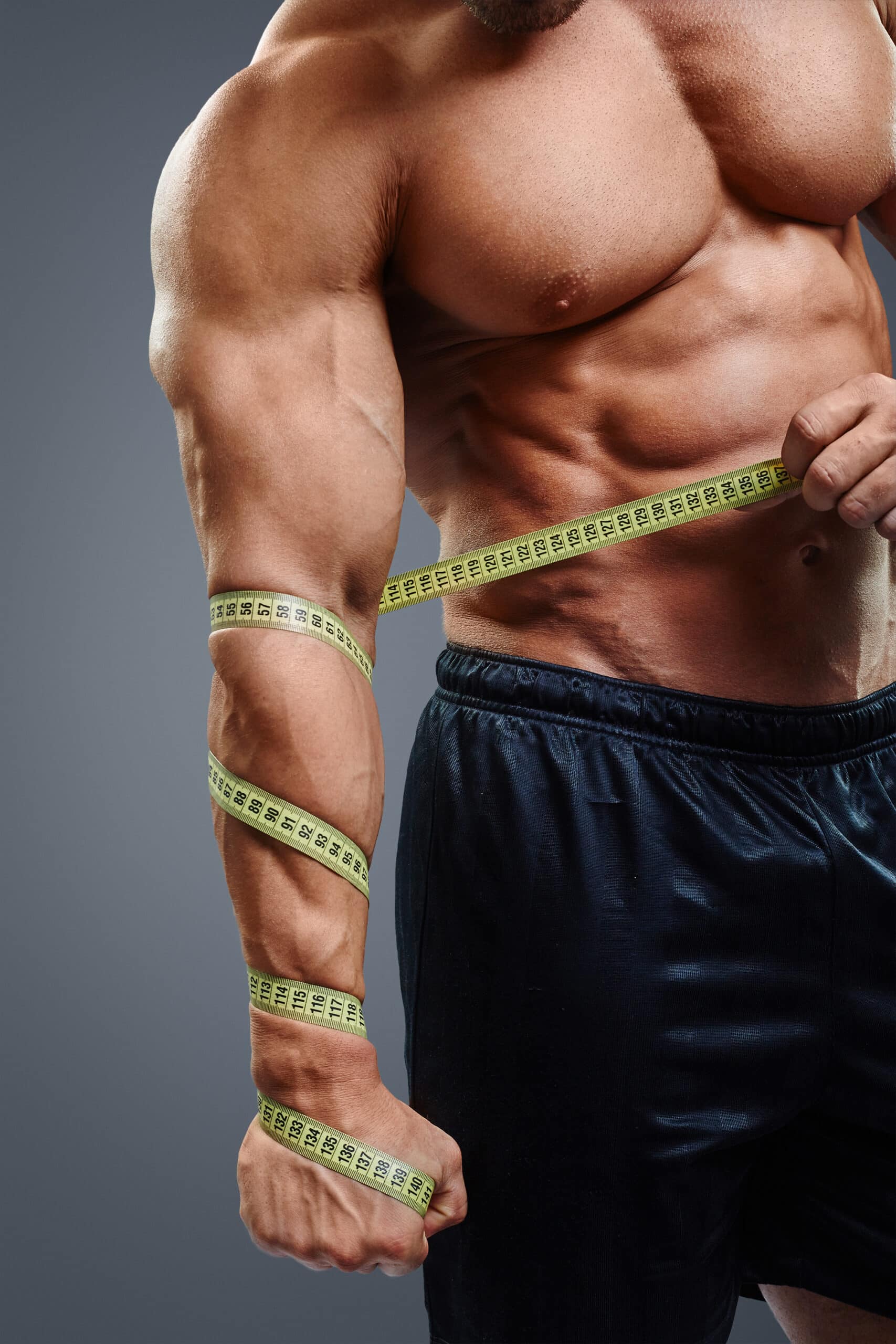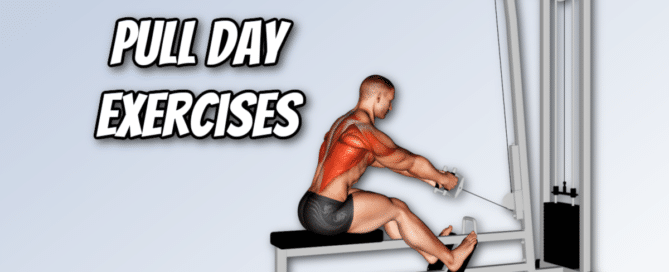Average Forearm Size & Circumference
By: Jeremy Fox, CNC, CPT – Published: December 12, 2023
Do you feel like your forearms are a bit too small or that they could use some bulking up? Well, you’re not alone!
Powerful forearms make any physique more impressive and increase your grip strength on upper body exercises. However, many people tend to overlook them when it comes to exercise and training.

In this blog post, we’ll explore the average forearm circumference measurement for men and women and discuss some effective ways to get bigger forearms. So, if you’re ready to roll up your sleeves and learn more about this underrated body part, keep reading!
How to Measure Forearms
Forearm size can be determined using various methods, such as measuring the length and circumference.
According to anthropometric surveys, forearm length is the linear distance between the elbow and wrist bones. On the other hand, forearm circumference is the distance around the widest part of the forearm while it is flexed.
To measure the length of your forearm, stand with your arm relaxed straight down by your side with your palm facing forward. Use a tape measure or beam caliper to measure the distance between the elbow and wrist bones. This may require assistance from another person.
To measure the circumference of your forearm, stand with your upper arm extended forward horizontally and your elbow flexed at a 90° angle. Clench your fist tightly with your palm facing your head. Use a flexible tape to measure the distance around the widest part of your forearm.

How to measure forearm length. Image from Anthropometric Survey of U.S. Army Personnel.

How to measure forearm circumference. Image from Anthropometric Survey of U.S. Army Personnel.
Average Forearm Size Statistics
In 2012, the US Army conducted measurements of over 6,000 military men and women to determine their body size. The measurements included forearm length and forearm circumference.
This data offers an intriguing insight into the average forearm size of relatively healthy adults. Let’s take a look at the numbers!
Average Forearm Length
According to the 2012 anthropometric survey, the average forearm length was 10.5 inches (26.7 cm) for men and 9.5 inches (24.0 cm) for women.
However, there is considerable variation in forearm length, mainly due to height. To illustrate, the table below shows forearm length percentiles for both genders. The 50th percentile is the average forearm size, while lower is smaller and higher is bigger.
Table 1. Forearm Length Percentiles For Men & Women
| Percentile | Men | Women |
|---|---|---|
| 5th | 9.6 inches (24.4 cm) | 8.6 inches (21.8 cm) |
| 10th | 9.8 inches (24.8 cm) | 8.8 inches (22.3 cm) |
| 15th | 9.9 inches (25.2 cm) | 8.9 inches (22.6 cm) |
| 25th | 10.1 inches (25.7 cm) | 9.1 inches (23.2 cm) |
| 50th | 10.5 inches (26.7 cm) | 9.5 inches (24.0 cm) |
| 75th | 10.9 inches (27.8 cm) | 9.9 inches (25.1 cm) |
| 85th | 11.1 inches (28.3 cm) | 10.2 inches (25.8 cm) |
| 90th | 11.3 inches (28.8 cm) | 10.3 inches (26.2 cm) |
| 95th | 11.6 inches (29.5 cm) | 10.6 inches (26.8 cm) |
Forearm length measurements are primarily related to your overall arm length and height. Once you reach adulthood, your forearm length will not change.
However, the circumference of your forearms is mainly related to the size of your forearm muscles. You can increase your muscle size by working out, which will directly affect the size of your forearm circumference.
So, let’s look at average forearm circumference to determine what’s big and small.
Average Forearm Circumference
On average, men have a forearm circumference of 12.2 inches (31.0 cm), while women’s forearms average 10.4 inches (26.3 cm) in circumference. These measurements are with the forearm flexed.
It’s important to note that there’s a significant range in forearm sizes on either side of the average. To help you understand what’s considered large or small, Table 2 below displays forearm measurements as percentiles.
Table 2. Forearm Circumference Percentiles For Men & Women (Flexed)
| Percentile | Men | Women |
|---|---|---|
| 5th | 10.8 inches (27.5 cm) | 9.3 inches (23.5 cm) |
| 10th | 11.1 inches (28.3 cm) | 9.5 inches (24.1 cm) |
| 15th | 11.3 inches (28.8 cm) | 9.7 inches (24.5 cm) |
| 25th | 11.6 inches (29.5 cm) | 9.9 inches (25.1 cm) |
| 50th | 12.2 inches (31.0 cm) | 10.4 inches (26.3 cm) |
| 75th | 12.8 inches (32.4 cm) | 10.9 inches (27.6 cm) |
| 85th | 13.1 inches (33.2 cm) | 11.1 inches (28.3 cm) |
| 90th | 13.3 inches (33.8 cm) | 11.3 inches (28.7 cm) |
| 95th | 13.7 inches (34.8 cm) | 11.7 inches (29.6 cm) |
Forearm Size & Proportions
How big or small your forearms appear is also a matter of proportion to your body. For example, longer bones tend to make your forearms look skinny. So, if you’re in the 90th percentile for forearm length, you should aim higher on forearm circumference as well.
Next, the size of your upper arms can affect how big your forearms look. If you have big biceps and triceps, you should also work on your forearms to prevent them from being disproportionately small.
Additionally, having smaller wrists can make your forearms appear larger when the muscles are well-developed. However, bigger wrist bones generally allow more potential forearm muscle and greater size.
Finally, having a higher body fat percentage or water weight can make your forearms larger, but ultimately they will look softer and more cylindrical. To create sweeping forearms, it’s best to have a lower body fat percentage and get rid of water retention.
How to Get Bigger Forearms
Building bigger forearms can be challenging because the flexor and extensor muscles are relatively small. In addition, they are used to getting worked as you hold and grip objects in your daily life. So they can be stubborn, like calf muscles.
Nevertheless, growing your forearms with an optimized workout and nutrition plan is possible.
Resistance Training
If you don’t lift weights, simply implementing a resistance training program can result in significant forearm growth. At first, you should notice forearm gains simply from gripping the bar during upper body exercises.
As you progress, however, you may require specific forearm training to get them to continue growing.
Forearm Exercises
You can directly train your forearms using exercises like wrist curls and reverse wrist curls, which target the flexor and extensor muscles. Additionally, specific bicep exercises like hammer curls and reverse curls are great for working the top of the forearm.
Forearm Workout
For most people, adding one or two of these exercises to your normal workout should be enough to stimulate new growth. But you may need to implement a forearm workout into your routine.
For stubborn forearms, I recommend having a dedicated forearm workout with two or three exercises specifically targeting your lower arms. I also like to add some abdominal and calf exercises to hit muscle groups that often get missed in other workouts.
Bodybuilding Diet
It’s important to keep in mind that the way you eat is just as crucial as your workout regimen when it comes to building muscle. To make progress in the gym, you need to provide your body with the necessary nutrients to help it grow.
Firstly, it’s essential to consume more calories than you burn each day to create a calorie surplus, which is crucial for gaining muscle consistently and developing thicker forearms.
Secondly, you need to eat enough protein, but the widely accepted rule of consuming 1 gram of protein per pound of body weight is not necessarily accurate. Your ideal protein intake depends on your lean mass, activity level, and fitness goals.
Another piece of nutrition advice is to focus on eating clean foods. This means avoiding junk food and choosing whole, natural foods for the best results. Finally, you can consider nutrient timing, which involves consuming most of your carbohydrates and calories around your workout.
Custom Meal Plan
Get a personalized meal plan designed specifically for your body and lifestyle. Including custom recipes formulated to fit your macros and calories – no counting required!
All this for just $13.99/mo! Click here to choose your plan.
Supplements
As a word of caution, do not expect supplements to grow your forearms in days or weeks miraculously. Instead, supplements are only an add-on to proper diet and exercise that may give you a slight boost.
In addition, there are a lot of expensive snake oil supplements that don’t deliver results. Here are some proven muscle-building supplements that can help you build bigger forearms.
More Body Measurements
If you enjoyed this article, you’re probably curious about average measurements for other body parts. So here is a list of some additional articles about body measurements and proportions.
Calf Size for Men & Women – How Big Is Healthy?
Neck Size and Health Implications
Average Waist Size for Men & Women
Butt Size by Gender, Age, & Ethnicity (with Charts)
Survey Reveals Average Thigh Circumference for Male & Female
Average Wrist Size & Why It Matters
Or if you’re all measured out, feel free to check out some of my other helpful content below! You’ll find information on topics ranging from supplements and workouts to bodybuilder bios.













